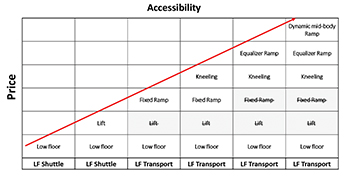By Ryan Lamb
![]() When paratransit operators’ interest and desire for low-floor accessible transit runs high, and “would if only they could” work them into the fleet, they are often hesitant to make the investment strictly as a matter of price. It’s a lot to pay to essentially carry the same number of passengers, they reason, as the cost of the vehicle goes up exponentially for kneeling functionality and a ramp in the entry.
When paratransit operators’ interest and desire for low-floor accessible transit runs high, and “would if only they could” work them into the fleet, they are often hesitant to make the investment strictly as a matter of price. It’s a lot to pay to essentially carry the same number of passengers, they reason, as the cost of the vehicle goes up exponentially for kneeling functionality and a ramp in the entry.
In face of this, I think it’s important to explain why low-floor paratransit buses, when looked at from a tiered accessibility approach, don’t have as many barriers to entry as some operators might think. This aims to resolve the issues for why agencies feel unable to move toward improved paratransit accessibility for one reason or another; whether it is a matter of price, or one of durability of the features available.
Building off the existing Champion bus low-floor platform, we have taken a new approach that incorporates unique combinations of low-floor and accessibility components at various price points. Given the “all or nothing” approach to accessible vehicles that has existed for years, these options in combination have not been available for agencies until now.
While this approach does not start with the epitome of paratransit service, it is low-floor access nonetheless. With clear-cut choices for the operator, the accessibility of the vehicle only gets better as the price of the vehicle increases.
 Entry-level low-floor accessibility
Entry-level low-floor accessibility
The most basic combination is a converted low floor chassis with a one-step entry and a wheelchair lift in place of a more expensive wheelchair ramp. A low floor vehicle with a wheelchair lift only raises passengers 18 inches which, by comparison, is safer than lifting them up to the height of a high-floor paratransit bus. Champion Bus calls this model the LF Shuttle.
Rather than an accessibility ramp at the entry door, the entry area has been leveled out into one wide step, 27 inches deep. Passengers using a walker can step onto the bus with greater stability, then step up into the lowered floor of the bus.
Shuttle to Transport
When we then add an entry ramp to the low-floor converted chassis, the vehicle rises a bit in in price, but also in comfort and quality for passengers using mobility aids. At Champion, we call vehicles at this tier and above the LF Transport.
Scaling up the LF Transport lowered floor paratransit bus with greater accessibility features, additional options include a kneeling suspension system, to decrease the entry step in height as well as the ramp angle for even greater accessibility.
At Champion, a REV Group brand, we think it’s important to offer both a 96- or 102-inch wide bus body; the same as an intercity bus, on each of the lowered floor combinations available. For the passenger, the extra width essentially duplicates the standard transit bus experience with a spacious maneuverable interior.
We see a lot of opportunities for this multi-level accessibility model in shuttle-type applications, such as parking lot and airport transportation companies, churches and retirement communities. The main idea is to appeal to those that have always shown interest in the low-floor concept, but have also remained conscious of its price tag.
The intent of every agency when complying with ADA should be to make sure every passenger is viewed as “just another passenger.” Preserving a sense of dignity can be as simple as making it easier for someone to get on and off the bus.
Working from this menu of accessibility options, we feel bus operators now stand a better chance of “getting in the game” and providing better paratransit service. Each combination of features brings an operator one step closer to totally-equal access in a market that appreciates anyone’s extra effort.
Accessibility in increments may prove to be a way to scale the wall, instead of just standing hopelessly before it.
Ryan Lamb serves as national director of sales for REV Bus Group. Visit www.revgroup.com for more information.
Ryan Lamb serves as national director of sales for REV Bus Group.
Visit www.revgroup.com for more information.
